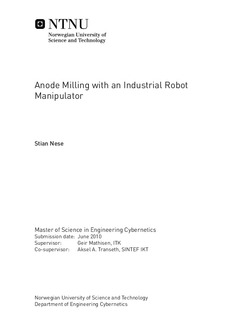Anode Milling with an Industrial Robot Manipulator
Master thesis
Permanent lenke
http://hdl.handle.net/11250/259974Utgivelsesdato
2010Metadata
Vis full innførselSamlinger
Sammendrag
Force control of robot manipulators will be needed in the future to fulfill the potential of automated solutions. For this to be possible, adequate control systems for this special purpose are required. This thesis proposes an extension to an existing force control approach found in the literature, based on direct force control, for the use of an industrial ABB robot in anode milling operations. This report presents a control system that aims to exercise force control with a robot manipulator, in order to conduct effective carbon anode milling. The control structure proposed contains both a position controller and a velocity controller, in order to enhance the final result. Because there is a gap between the theory on robot force control and the features usually available on an industrial robot, this control system is modified to be directly implementable on a standard industrial ABB robot manipulator. Simulations, and subsequent comparison, of both this control system and a control system typically found in the industry, which is based on PID control of the milling tool power consumption, are conducted. ABB s Robot- Studio is used to perform the simulations, where models of the tool, anode and coke are used. From these simulations we see that the industrial PID controller performs very well, and that the newly proposed control approach does not quite reach the same level of performance.
